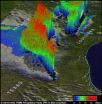(Press-News.org) NASA's Tropical Rainfall Measuring Mission (TRMM) satellite provides a look at thunderstorms in three dimensions and shows scientists the heights of the thunderclouds and the rainfall rates coming from them, both of which indicate severity.
Powerful thunderstorms that created severe weather were more than 8 miles high.
NOAA's National Weather Service Storm Prediction Center received 18 reports of tornadoes occurring on April 3 over northeastern Texas. Some of these very destructive storms dropped softball sized hail as they passed to the south of the Dallas/Fort Worth area.
To see a simulated flyby from the TRMM satellite around these storms, visit: http://trmm.gsfc.nasa.gov/images_dir/tornadic_tstms_4apr12_0133_utc_radar_animated.gif (28 MB animated gif).
INFORMATION:
TRMM is a joint mission between NASA and the Japanese Space Agency, JAXA. NASA and JAXA are currently collaborating on the follow-on mission called the Global Precipitation Measurement (GPM) mission. The GPM mission will provide a new generation of satellite observations of rain and snow worldwide every three hours for scientific research and societal benefits.
NASA's TRMM Satellite sees tornadic Texas storms in 3-D
2012-04-10
ELSE PRESS RELEASES FROM THIS DATE:
Women cannot rewind the 'biological clock'
2012-04-10
Many women do not fully appreciate the consequences of delaying motherhood, and expect that assisted reproductive technologies can reverse their aged ovarian function, Yale researchers reported in a study published in a recent issue of Fertility and Sterility.
"There is an alarming misconception about fertility among women," said Pasquale Patrizio, M.D., professor in the Department of Obstetrics & Gynecology at Yale School of Medicine and director of the Yale Fertility Center. "We also found a lack of knowledge about steps women can take early in their reproductive ...
Salk scientists redraw the blueprint of the body's biological clock
2012-04-10
La Jolla, CA----The discovery of a major gear in the biological clock that tells the body when to sleep and metabolize food may lead to new drugs to treat sleep problems and metabolic disorders, including diabetes.
Scientists at the Salk Institute for Biological Studies, led by Ronald M. Evans, a professor in Salk's Gene Expression Laboratory, showed that two cellular switches found on the nucleus of mouse cells, known as REV-ERBα and REV-ERBβ, are essential for maintaining normal sleeping and eating cycles and for metabolism of nutrients from food.
The findings, ...
Which plants will survive droughts, climate change?
2012-04-10
New research by UCLA life scientists could lead to predictions of which plant species will escape extinction from climate change.
Droughts are worsening around the world, posing a great challenge to plants in all ecosystems, said Lawren Sack, a UCLA professor of ecology and evolutionary biology and senior author of the research. Scientists have debated for more than a century how to predict which species are most vulnerable.
Sack and two members of his laboratory have made a fundamental discovery that resolves this debate and allows for the prediction of how diverse ...
Long-term studies detect effects of disappearing snow and ice
2012-04-10
Ecosystems are changing worldwide as a result of shrinking sea ice, snow, and glaciers, especially in high-latitude regions where water is frozen for at least a month each year—the cryosphere. Scientists have already recorded how some larger animals, such as penguins and polar bears, are responding to loss of their habitat, but research is only now starting to uncover less-obvious effects of the shrinking cryosphere on organisms. An article in the April issue of BioScience describes some impacts that are being identified through studies that track the ecology of affected ...
Long-term research reveals causes and consequences of environmental change
2012-04-10
WASHINGTON, D.C., APRIL 6, 2012—As global temperatures rise, the most threatened ecosystems are those that depend on a season of snow and ice, scientists from the nation's Long Term Ecological Research (LTER) Network say."The vulnerability of cool, wet areas to climate change is striking," says Julia Jones, a lead author in a special issue of the journal BioScience released today featuring results from more than 30 years of LTER, a program of the National Science Foundation (NSF).
In semi-arid regions like the southwestern United States, mountain snowpacks are the dominant ...
Long-term neuropsychological impairment is common in acute lung injury survivors
2012-04-10
Cognitive and psychiatric impairments are common among long-term survivors of acute lung injury (ALI), and these impairments can be assessed using a telephone-based test battery, according to a new study.
"Neuropsychological impairment is increasingly being recognized as an important outcome among survivors of critical illness, but neuropsychological function in long-term ALI survivors has not been assessed in a multi-center trial, and evidence on the etiology of these impairments in ALI survivors is limited," said lead author Mark E. Mikkelsen, MD, MSCE, assistant professor ...
Scientists forecast forest carbon loss
2012-04-10
When most people look at a forest, they see walking trails, deer yards, or firewood for next winter. But scientists at the Harvard Forest and Smithsonian Institution take note of changes imperceptible to the naked eye -- the uptake and storage of carbon. What they've learned in a recent study is that an immense amount of carbon is stored in growing trees, but if current trends in Massachusetts continue, development would reduce that storage by 18 percent over the next half century. Forest harvesting would have a much smaller impact.
Jonathan Thompson is Research Ecologist ...
Coordinating the circadian clock: Molecular pair controls time-keeping and fat metabolism
2012-04-10
PHILADELPHIA — The 24-hour internal clock controls many aspects of human behavior and physiology, including sleep, blood pressure, and metabolism. Disruption in circadian rhythms leads to increased incidence of many diseases, including metabolic disease and cancer. Each cell of the body has its own internal timing mechanism, which is controlled by proteins that keep one another in check.
One of these proteins, called Rev-erb alpha, was thought to have a subordinate role because the clock runs fairly normally in its absence. New work, published in Genes and Development ...
Researchers use game to change how scientists study disease outbreaks
2012-04-10
It may seem like a game of tag, but it's an innovative tool for teaching the fundamentals of epidemiology, the science of how infectious diseases move through a population.
An international team of scientists--including researchers who teach an annual clinic at the African Institute for Mathematical Sciences (AIMS) in Muizenberg, South Africa--is helping epidemiologists improve the mathematical models they use to study outbreaks of diseases like cholera, AIDS and malaria.
In 2011, attendees at the clinic were treated to a game of "Muizenberg Mathematical Fever," where ...
Scientists identify major source of cells' defense against oxidative stress
2012-04-10
Both radiation and many forms of chemotherapy try to kill tumors by causing oxidative stress in cancer cells. New research from USC on a protein that protects cancer and other cells from these stresses could one day help doctors to break down cancer cells' defenses, making them more susceptible to treatment.
In the March 23 issue of the Journal of Biological Chemistry, scientists led by USC Professor Kelvin J. A. Davies demonstrated that a protein known as Nrf2 governs a cell's ability to cope with oxidative stress by increasing the expression of key genes for removing ...



